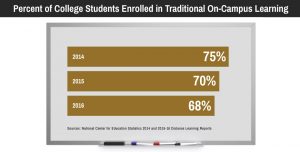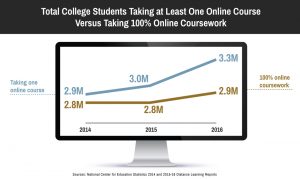As technology advances, online classrooms are more readily available (Purdue University Global., 2018). Although, there is a debate as to which avenue is more superior: face-to-face learning vs. online classrooms. There are many factors that come into play when comparing the difference between online classrooms to the traditional on-campus classroom. The final question remains: which one is the better option?
Both online learning and on-campus learning have their strengths and weaknesses. One should take into account what works best based on their personal needs and circumstances. Work status is a criteria that may impact a student’s choice when picking between the two. Working a part-time job may give you more flexibility between the two options, depending on your schedule and your personal preference. Meanwhile, if you are an individual that works a full-time position you may find it more feasible with online courses (Purdue University Global., 2018) as they tend to offer a more flexible schedule. Online classes can allow you to mold the course to your schedule and allow you to log into the online course at a time that is feasible for your schedule (Erstad, W., 2017). Evaluation of the time and schedule is a factor to consider when deciding which classroom setting works best for you. Location can also be a factor. One also needs to consider where they live. If a student is unable to relocate to campus on a regular basis, distance learning provides access to programs virtually all over the world (Purdue University Global., 2018). If there are mental or physical barriers a student faces, an online classroom may help ease some of those challenges.
Comparing the effectiveness of online learning and in-class learning is a contributing factor. Online education may not have the same sense of instructor control and group dynamic (Purdue University Global., 2018). The social interaction between the two classroom settings differs. A classroom setting allows for face-to-face interaction with your peers and instructors while online allows for an independent study environment. Social interaction may be limited to online courses. Online video chat and discussion can provide some form of interaction within the classroom. Those who thrive on human interaction may need classroom settings to learn. Seeing and interacting with your instructor on a regular basis can be motivating for some (Erstad, W., 2017). Classroom setting also allows for spur-of-the-moment questioning and interaction (Erstad, W., 2017). Response time and communication may be slower online than in-class. For instance, a conversation over email may be more tedious and require more time than a face-to-face conversation. A classroom setting allows students to ask questions at the moment and allows for more easily to network. Although, the quality of feedback tends to be more detailed and focused online compared to classroom settings (Purdue University Global., 2018). Students may be more responsible for learning the material with online classes and may not have as much guidance from the professor when taking courses online.
An individual’s discipline and self-motivation are factors to consider when comparing the two. Online and traditional education requires discipline to succeed, and there can be a significant difference between how learning is structured between the two (Erstad, W., 2017). Individuals are often able to manage their own schedules when doing online classes. This allows the students some aspects of flexibility and convenience that the classroom setting cannot offer. Studying at any time, wherever you would like, is a luxury online classes provide. Online classrooms can allow students more flexibility in scheduling their course into their work and living responsibly. Students are able to log into the course and educate themselves about the material at their own pace. Conversely, online courses may require individuals to be more self-motivated and some students may struggle with the flexibility and self-management that comes with online courses. Having a routine of going to class and having face-to-face interaction may help students to be more motivated. Classroom settings can be beneficial in reminding students of upcoming assignments and avoid procrastination.
Traditional classrooms are still the most common way of learning, although, in recent years, there has been a decline in this type of learning (Purdue University Global., 2018). 
Online education has become a more appealing option for many students. The diagram below demonstrates there has been an increase in online courses (Purdue University Global., 2018).
When comparing online classroom to on-campus classroom, there are many factors that come into play. It is not to say that one is better than the other but rather what works best for you. Every student has their own factors that they need to consider and it is up to them to decide what works best for them.
Erstad, W. (2017, August 16). Online vs. Traditional Education: What You Need to Know. Retrieved from https://www.rasmussen.edu/student-experience/college-life/online-vs-traditional-education-answer-never-expected/
Purdue University Global. (2018, May 15). Classroom vs. Online Education. Retrieved from https://www.purdueglobal.edu/blog/student-life/classroom-versus-online/